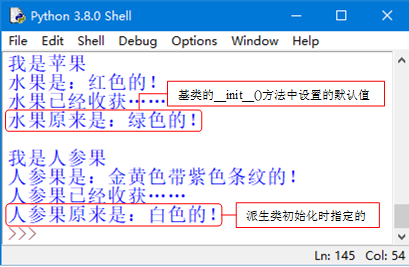自学python如何成为大佬(目录):https://blog.csdn.net/weixin_67859959/article/details/139049996?spm=1001.2014.3001.5501
在派生类中定义__init__()方法时,不会自动调用基类的__init__()方法。例如,定义一个Fruit类,在__init__()方法中创建类属性color,然后在Fruit类中定义一个harvest()方法,在该方法中输出类属性color的值,再创建继承自Fruit类的Apple类,最后创建Apple类的实例,并调用harvest()方法,代码如下:
class Fruit: # 定义水果类(基类)
def __init__(self,color = "绿色"):
Fruit.color = color # 定义类属性
def harvest(self):
print("水果原来是:" + Fruit.color + "的!") # 输出的是类属性color
class Apple(Fruit): # 定义苹果类(派生类)
def __init__(self):
print("我是苹果")
apple = Apple() # 创建类的实例(苹果)
apple.harvest() # 调用基类的harvest()方法
执行上面的代码后,将显示如图20所示的异常信息。

图20 基类的__init__()方法未执行引起的异常
因此,要让派生类调用基类的__init__()方法进行必要的初始化,需要在派生类使用super()函数调用基类的__init__()方法。例如,在上面代码的第8行代码的下方添加以下代码:
super().__init__() # 调用基类的__init__()方法
注意:在添加上面的代码时,一定要注意缩进的正确性。
运行后将显示以下正常的运行结果:
我是苹果
水果原来是:绿色的!
下面通过一个具体实例演示派生类中调用基类的__init__()方法的具体的应用。
![]()
实例05 在派生类中调用基类的__init__()方法定义类属性
在IDLE中创建一个名称为fruit.py的文件,然后在该文件中定义一个水果类Fruit(作为基类),并在该类中定义__init__()方法,在该方法中定义一个类属性(用于保存水果默认的颜色),然后在Fruit类中定义一个harvest()方法,再创建Apple类和Sapodilla类,都继承自Fruit类,最后创建Apple类和Sapodilla类的实例,并调用harvest()方法(在基类中编写),代码如下:
class Fruit: # 定义水果类(基类)
def __init__(self, color="绿色"):
Fruit.color = color # 定义类属性
def harvest(self, color):
print("水果是:" + self.color + "的!") # 输出的是形式参数color
print("水果已经收获……")
print("水果原来是:" + Fruit.color + "的!") # 输出的是类属性color
class Apple(Fruit): # 定义苹果类(派生类)
color = "红色"
def __init__(self):
print("我是苹果")
super().__init__() # 调用基类的__init__()方法
class Sapodilla(Fruit): # 定义人参果类(派生类)
def __init__(self, color):
print("\n我是人参果")
super().__init__(color) # 调用基类的__init__()方法
# 重写harvest()方法的代码
def harvest(self, color):
print("人参果是:" + color + "的!") # 输出的是形式参数color
print("人参果已经收获……")
print("人参果原来是:" + Fruit.color + "的!") # 输出的是类属性color
apple = Apple() # 创建类的实例(苹果)
apple.harvest(apple.color) # 调用harvest()方法
sapodilla = Sapodilla("白色") # 创建类的实例(人参果)
sapodilla.harvest("金黄色带紫色条纹") # 调用harvest()方法
执行上面的代码,将显示如图21所示的运行结果。

图21 在派生类中调用基类的__init__()方法定义类属性




















